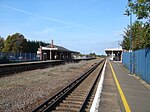Spade House
Arts and Crafts architecture in EnglandBuildings by C.F.A. VoyseyCountry houses in KentFolkestone and Hythe DistrictGrade II* listed buildings in Kent ... and 4 more
Grade II* listed housesH. G. WellsHouses completed in 1903Kent building and structure stubs

Spade House was the home of the science fiction writer H. G. Wells from 1901 to 1909. It is a large mansion overlooking Sandgate, near Folkestone, in southeast England.
Excerpt from the Wikipedia article Spade House (License: CC BY-SA 3.0, Authors, Images).Spade House
Vicarage Road, Folkestone and Hythe District Coolinge
Geographical coordinates (GPS) Address External links Nearby Places Show on map
Geographical coordinates (GPS)
| Latitude | Longitude |
|---|---|
| N 51.074722222222 ° | E 1.1523611111111 ° |
Address
Spade House
Vicarage Road
CT20 3AD Folkestone and Hythe District, Coolinge
England, United Kingdom
Open on Google Maps





